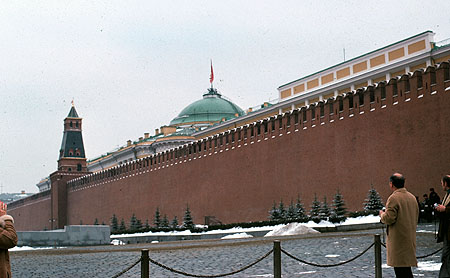
Wondering what was going on behind the high walls of the Kremlin?
In the "old" days, before the fall of the Iron Curtain and the collapse of communist regimes around the world, there were scholars called "Kremlinologists" whose avowed task was to study the documents, audio and video materials, pronouncements, statements, and imagery of communist leadership to discover what was REALLY going on in those communist countries. These Kremlinologists produced an enormous amount of material in which they tried to explain past communist actions and also to predict future policies and endeavors. Note that there were Kremlinologists in both the private (university) and government (defense or CIA) sectors, and in both cases their work could be made public or kept private (secret).
In this instance, as an example of what Kremlinologists did, I have gathered some materials relevant to the Moscow Conference of Leaders of the 81 Communist Parties, which, of course, took place in Moscow, basically in November 1960 (a previous such conference had been held in 1957).
- Statement of the Moscow Conference of Representatives of Communist and Workers Parties, published 6 December 1960 (large *.pdf file). (See the original in Russian.)
- A Report by Khrushchev on the Moscow Conference, formally titled, "For New Victories of the World Communist Movement," which Khrushchev read at a meeting of communist party personnel at the Higher Party School, the Academy of Sciences and the Institute of Marxism-Leninism in Moscow on 6 January 1961. The text of this report was then published in Kommunist, January 1961. (large *.pdf file)
- Analysis of the Statement by the Central Research Department, Radio Liberty, Munich
- Another analysis of the statement of the conference by the Soviet Affairs Analysis Service, a product of the Institute for the Study of the USSR, Munich
These documents were all part of files kept by Professor Thomas T. Hammond, one of my advisors at the University of Virginia. This is exactly the kind of material that a Kremlinologist would work with. Here are some comments on my part:
- You can see the extensive notations on the two long, programmatic documents by Hammond. A Kremlinologist, as skilled as he was, would have been very familiar with the particulars of language used in the document, and he would be looking for changes in wording or phrases from previous documents.
- Note also the length of these documents. Can you imagine sitting there and listening to Khrushchev read 45 pages of text in January 1961? But this was a standard practice that communist leaders were very good at subjecting their audiences to. I may be completely wrong on this, but I think that one of Brezhnev's addresses at a party congress lasted something like seven hours. Plus, you didn't dare fall asleep!
- The two analyses were done by organizations deeply involved in the study of the communist world in the 1950s-1980s. Radio Liberty, along with Radio Free Europe, were US government-sponsored organizations designed to counter communism by broadcasting news to countries behind the Iron Curtain ( Voices of Hope: The Story of Radio Free Europe and Radio Liberty). There were numerous organizations producing such analyses of the communist world.
Now, looking at these documents, you might not know it on first glance, but they were important indicators of policy disagreements that were taking place in the communist world at that time between Russia and China; disagreements that would lead, in time, to the so-called Sino-Soviet split. A historical note: The Russians and Chinese have not really gotten along very well for about two centuries now.